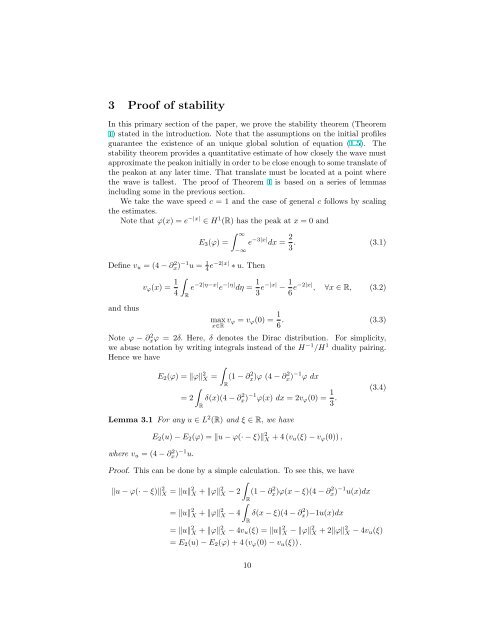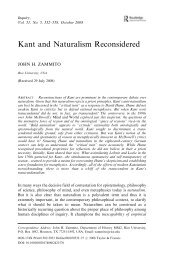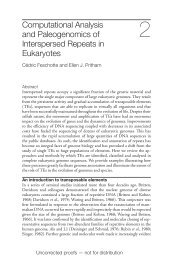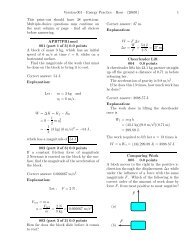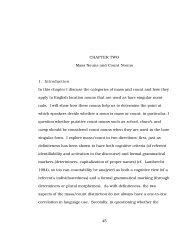Stability of Peakons for the Degasperis-Procesi Equation
Stability of Peakons for the Degasperis-Procesi Equation
Stability of Peakons for the Degasperis-Procesi Equation
Create successful ePaper yourself
Turn your PDF publications into a flip-book with our unique Google optimized e-Paper software.
3 Pro<strong>of</strong> <strong>of</strong> stability<br />
In this primary section <strong>of</strong> <strong>the</strong> paper, we prove <strong>the</strong> stability <strong>the</strong>orem (Theorem<br />
1) stated in <strong>the</strong> introduction. Note that <strong>the</strong> assumptions on <strong>the</strong> initial pr<strong>of</strong>iles<br />
guarantee <strong>the</strong> existence <strong>of</strong> an unique global solution <strong>of</strong> equation (1.5). The<br />
stability <strong>the</strong>orem provides a quantitative estimate <strong>of</strong> how closely <strong>the</strong> wave must<br />
approximate <strong>the</strong> peakon initially in order to be close enough to some translate <strong>of</strong><br />
<strong>the</strong> peakon at any later time. That translate must be located at a point where<br />
<strong>the</strong> wave is tallest. The pro<strong>of</strong> <strong>of</strong> Theorem 1 is based on a series <strong>of</strong> lemmas<br />
including some in <strong>the</strong> previous section.<br />
We take <strong>the</strong> wave speed c = 1 and <strong>the</strong> case <strong>of</strong> general c follows by scaling<br />
<strong>the</strong> estimates.<br />
Note that ϕ(x) = e −|x| ∈ H 1 (R) has <strong>the</strong> peak at x = 0 and<br />
E 3 (ϕ) =<br />
∫ ∞<br />
−∞<br />
e −3|x| dx = 2 3 . (3.1)<br />
Define v u = (4 − ∂x) 2 −1 u = 1 4 e−2|x| ∗ u. Then<br />
v ϕ (x) = 1 ∫<br />
e −2|η−x| e −|η| dη = 1 4<br />
3 e−|x| − 1 6 e−2|x| , ∀x ∈ R, (3.2)<br />
and thus<br />
R<br />
max v ϕ = v ϕ (0) = 1<br />
x∈R 6 . (3.3)<br />
Note ϕ − ∂xϕ 2 = 2δ. Here, δ denotes <strong>the</strong> Dirac distribution. For simplicity,<br />
we abuse notation by writing integrals instead <strong>of</strong> <strong>the</strong> H −1 /H 1 duality pairing.<br />
Hence we have<br />
∫<br />
E 2 (ϕ) = ‖ϕ‖ 2 X = (1 − ∂x)ϕ 2 (4 − ∂x) 2 −1 ϕ dx<br />
R<br />
∫<br />
= 2 δ(x)(4 − ∂x) 2 −1 ϕ(x) dx = 2v ϕ (0) = 1 (3.4)<br />
3 .<br />
R<br />
Lemma 3.1 For any u ∈ L 2 (R) and ξ ∈ R, we have<br />
where v u = (4 − ∂ 2 x) −1 u.<br />
E 2 (u) − E 2 (ϕ) = ‖u − ϕ(· − ξ)‖ 2 X + 4 (v u (ξ) − v ϕ (0)) ,<br />
Pro<strong>of</strong>. This can be done by a simple calculation. To see this, we have<br />
∫<br />
‖u − ϕ(· − ξ)‖ 2 X = ‖u‖ 2 X + ‖ϕ‖ 2 X − 2 (1 − ∂x)ϕ(x 2 − ξ)(4 − ∂x) 2 −1 u(x)dx<br />
R<br />
∫<br />
= ‖u‖ 2 X + ‖ϕ‖ 2 X − 4 δ(x − ξ)(4 − ∂x)−1u(x)dx<br />
2<br />
R<br />
= ‖u‖ 2 X + ‖ϕ‖ 2 X − 4v u (ξ) = ‖u‖ 2 X − ‖ϕ‖ 2 X + 2‖ϕ‖ 2 X − 4v u (ξ)<br />
= E 2 (u) − E 2 (ϕ) + 4 (v ϕ (0) − v u (ξ)) .<br />
10


